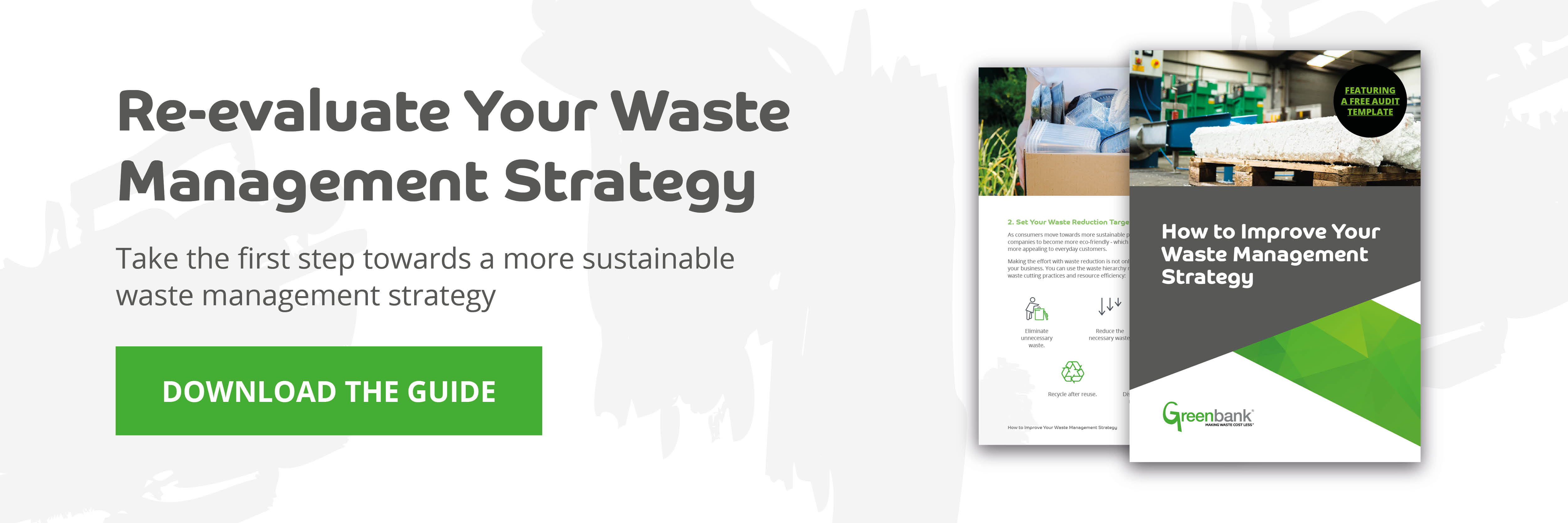Manufacturing processes are key drivers of waste production in any business. While waste management processes will, more often than not, have been put in place, there’s always room for improvement.
This improvement comes from training employees to use waste management machinery effectively, understanding the need for waste reduction and making sure costs can be reduced through proper waste handling.
In light of that, many manufacturing executives are asking the questions, “How can I reduce my manufacturing waste in a sustainable way?”. Well, look no further. This blog will detail the most effective and easily applicable waste reduction methods.
- Consider Closed-Loop Manufacturing
- Make Use of Waste Packaging
- Reuse Materials
- Reduce Waste Volume
- Look After Your Waste Management Machinery
1. Consider Closed-Loop Manufacturing
Making things ‘closed-loop’ is an increasingly popular idea. It’s a methodology that relates to ideas of circular economies and full system recycling. While it’s not a walk in the park, it’s definitely possible for a lot of industries.
Closed-loop manufacturing works by extending the lifespans of what were previously considered to be waste materials, reintroducing them into the manufacturing lifecycle through system innovations. Similarly, it also means utilising recycled products instead of virgin materials in order to lessen environmental impact – closely following the 5 R’s of waste management.
By utilising your waste for something other than the landfill, you can adequately satisfy looking to reduce your manufacturing waste.
Are there any ways you can reuse your waste? For example, are any raw materials being delivered in packaging that uses polystyrene? This is one product that can quite easily be reused for other purposes.
2. Make Use of Waste Packaging
To be more sustainable, innovation is key. The manufacturing industry will always utilise packaging when transporting anything, from raw materials to finished products. Because of this, the sustainable thing to do is make sure that waste packaging can be properly recycled.
This means packaging must be sorted and baled. For example, plastic and cardboard can be easily fed into vertical balers to create easily transported, volume-reduced bales of waste product. These are easily recycled and could even be sold, creating a viable revenue stream for your waste products.
3. Reuse Materials
While many manufacturers won’t be able to utilise processes such as filtration, electrolysis, centrifugation or reverse osmosis, it doesn’t mean materials can’t be reused in simpler terms.
Similar to closed-loop manufacturing, the use of recyclables is another sustainable way to reduce waste. You will first need to accurately sort your waste to discover if any materials can be reused. If not, simply recycle them. Who knows – those recycled materials might make their way back to you.
Sorting waste is important. It’s very easy for people strapped for time to just throw everything in one bin, but you need to make sure that employees are aware of the impact of this on your bottom line – less recycling means more money spent on landfill tax and more inefficiency.
To sort your waste, you can use stuffer frames, ideal for waste segmentation. These are metal frames, designed to be lightweight and moveable, in which waste is easily separated into.
So remember, while your waste might not be immediately useful for you, it might be useful for another business. Even though you’re getting rid of it, at this point if it’s recycled, it’s not really waste – but becomes a useful material for others to utilise.
4. Reduce Waste Volume
When people think of reducing waste, they usually think of individual items. However, you can also think of waste as volume, which is potentially a more reliable indicator of how much waste you produce. It is waste size, not quantity, that dictates how much space you need to store it in, how many skips you should hire, how many collection trips you need.
When you can effectively reduce the volume of your waste, the costs associated with the above all come down. So how do you reduce waste volume? By utilising waste management machinery. For example:
- Vertical balers are perfect for baling cardboard and polythene into easy-to-move bales.
- Polystyrene compactors can take waste polystyrene and turn it into ‘bricks’, which you can use for other needs or sell on, creating new revenue streams.
- Static compactors work fantastically well on reducing the volume of big, bulky items, meaning you can fit more in skips or in waste collection trucks, further reducing your costs.
5. Look After Waste Management Machinery
If you’ve already got waste management machinery, make sure you’re keeping it ship-shape. The key word we’ll focus on is ‘preventative maintenance’, making sure you’re regularly checking on your waste management machinery to make sure it’s always functioning at 100% capacity.
Damaged equipment, even messy equipment, can reduce the efficiency of your waste management. You need to make sure that all of your machines are in the best condition they can be. This means you can accurately deal with the waste you produce and still reduce volume and the amount you have to send to landfill.
Similarly, you should also be looking at the energy efficiency of your older machinery. Sometimes, it’s not a sustainable option to use this machinery if it’s taking a large amount of power just to bale a small amount of waste.
In all, carrying out maintenance now will save on having to pay for a breakdown later. At Greenbank, we offer waste machinery servicing plans – ensuring your equipment remains in tip-top shape.
How To Improve Waste Management Strategy
No one wants their waste management to get in the way of business growth. While some think of it as an afterthought, it’s actually a business-critical consideration, affecting not only your costs, but your compliance as well.
To see just how you could be improving your waste management strategies, download our resource. Inside, we cover the best practices for waste management, how to conduct a waste audit and key advice on both waste management machinery and waste management providers.
Using this guide, you’ll be able to better manage your waste, ensure your machinery is effective and communicate your waste management strategy to your employees and colleagues.
To download your copy, click the button below.

Manufacturing Waste Management




